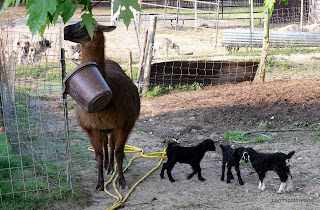Possibly the most common question I get at shows is "How long did it take to make that __________?"
 |
Close up of the Thy/Fes shawl in the fringing process. I tied
the fringes in a simple lacey pattern. |
Some of my items I keep detailed records on, others I just guess. I rarely figure in the time spent caring for the animals who grew the fleeces in our intensive, small acreage set-up.
I am just starting to figure it up for the shawl I am finishing this morning. I tied the last fringes on it last night and hand washed it one more time to wet finish it. Currently it is soaking in a creme rinse bath, to accentuate how soft and drapey it is.
This shawl started forming in my mind last winter, when I wanted blue yarns. I had Lena dye several different batches of wool and mohair with the 4 different blue colors of Jacquard dye I bought. I spun blue mohair with natural wool, natural mohair with blue wool, blue, blue and more blue. I still like it.
I was finishing spinning Fes' mohair about the time I started spinning Thy's blue wool. They came out a similar weight and drape, so I plied them together. The yarn came out so beautiful I instantly put it into the "I get to weave with that" pile.
 |
Thyme, our oldest ewe, with her daughter Basil behind her.
Ty-ty is 12-years-old this year.
She has one tooth remaining, so she gets soft food.
Her fleece is still soft, shiny and a joy to spin. |
As soon as I finished the winter black and red shawl on my loom at the house, I started this one. It wove faster than any other shawl I've worked on this year. This yarn wanted to be a shawl. In less than a month, I was tying on the fringes.
I knew exactly the look I wanted with the fringes. Fringing with handspun yarn can be a challenge. Unless I want the yarn to fray, you have to knot every end. There are 465 fringes on this shawl. That means 930 ends to knot. Plus tying each fringe on. Then I knotted them down in a pattern. It took me almost a month to tie the 2,325 knots in the fringe on this shawl.
Most of you know that I do most of my work for a few hours in the evening each day, or a few hours in the early morning and occasionally at night when I can't sleep. So those months are not constant labor.
 |
Fes, left, now lives with a flock up on Dodd mountain.
He still thinks very highly of himself. |
To try to break it down -
Critter time
This is one year of Thy's life growing this fleece.
It is 6 months of Fes' fleece.
Lena and I spend one hour every morning and one hour each night on chores for the 29 sheep, 10 dairy goats, 11 angora goats, one horse and one llama that are currently in our flocks. That's 730 hours per year just feeding time. That comes out to 14 hours per critter.
It takes us about an hour to shear, trim toes and check over each animal at shearing time.
It took about an hour to wash the fleece.
It took Lena about an hour working time to dye the wool.
It took me 12 hours to spin the singles of Fes' mohair, but I did do several hats out of it, too.
It took me about 7 hours to spin Thye's wool.
It took another 8 hours to ply the two together.
 |
Dyed Thyme wool plied with natural color Fes kid mohair yarn.
Washed, dyed, spun, plied, washed again and ready to weave. |
Washing the finished skeins took an hour.
Weaving time on this shawl was super fast. Time at the loom was only 11 hours.
Fringing time, all told, 12 hours.
Last nights hand wash and setting up the soak bath 1/2 hour. This morning's yet to come rinsing and blocking to dry 1/2 hour.
When finished and hung up on the rack to sell, this shawl will have 69 hours of my and Lena's time invested in its creation.
In addition to hours, our feed bill for the year is $5,060. That's $97.31 per animal. We shear the sheep once a year and the angoras twice, so the mohair only costs $48.65/fleece.
What price do you think I should write on the tag of this beautiful, unique shawl?





















